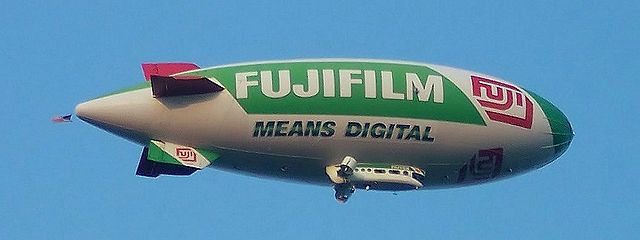Loading AI tools
Japanese conglomerate started as photographic film manufacturer From Wikipedia, the free encyclopedia
Fujifilm Holdings Corporation (富士フイルムホールディングス株式会社, Fuji-fuirumu Hōrudingusu kabushiki gaisha), trading as Fujifilm (富士フイルム, Fuji-fuirumu), or simply Fuji, is a Japanese multinational conglomerate headquartered in Tokyo, Japan, operating in the areas of photography, optics, office and medical electronics,[2][3][4] biotechnology,[5][6] and chemicals.[7][8]
Current logo since October 1, 2006 | |
 Midtown West, the current global headquarters of Fujifilm in Tokyo | |
Native name | 富士フイルムホールディングス株式会社 |
|---|---|
Romanized name | Fuji-fuirumu Hōrudingusu kabushiki gaisha |
| Company type | Public |
| Industry | |
| Founded | January 20, 1934 |
| Headquarters | Midtown West, Tokyo Midtown Akasaka, Minato, Tokyo, Japan |
Area served | Worldwide |
Key people | |
| Products |
|
| Revenue | |
| Total assets | |
Number of employees | 73,906 (2019)[1] |
| Website | holdings.fujifilm.com |
The company started as a manufacturer of photographic films, which it still produces. Fujifilm products include document solutions, medical imaging and diagnostics equipment, cosmetics, pharmaceutical drugs, regenerative medicine, stem cells, biologics manufacturing, magnetic tape data storage, optical films for flat-panel displays, optical devices, photocopiers, printers, digital cameras, color films, color paper, photofinishing and graphic arts equipment and materials.[2][4][9][10][11]
Fujifilm is part of the Sumitomo Mitsui Financial Group financial conglomerate (keiretsu).

Fuji Photo Film Co., Ltd. was established in 1934 as a subsidiary of Daicel producing photographic films. In the 1940s, Fuji Photo entered the optical glasses, lenses and equipment markets. In 1962, Fuji Photo and UK-based Rank Xerox Limited (now Xerox Limited) launched Fuji Xerox Co., Ltd. through a joint venture.[citation needed]
From the mid-1950s, Fuji Photo began establishing overseas sales bases. In the 1980s, the company expanded its production and other operations internationally. During this period, Fuji Photo developed digital technologies for its photography, medical, and printing sectors. This led to the invention of computed radiography (CR), which addressed several problems associated with traditional radiography, including reducing radiation exposure for both technicians and patients. Fujifilm's systems were marketed and sold under the FCR brand.[12]
Like its rival Eastman Kodak which dominated in the US, Fuji Photo enjoyed a longtime near-monopoly on camera film in Japan.[citation needed] Fuji increased market share in the US by becoming one of the title sponsors of the 1984 Los Angeles Olympics, offering cheaper camera film, and establishing a film factory in the US.[citation needed]
In 1994 vice president Juntarō Suzuki announced that the company would halt paying sōkaiya, a type of protection racket bribe, to Yakuza. In retaliation he was murdered in front of his home by Yakuza.[13] In May 1995, Kodak filed a petition with the US Commerce Department under section 301 of the Commerce Act arguing that its poor performance in the Japanese market was a direct result of unfair practices adopted by Fuji. The complaint was lodged by the US with the World Trade Organization. On January 30, 1998, the WTO announced a "sweeping rejection of Kodak's complaints" about the film market in Japan.[14][15]
In March 2006, Noritsu and Fuji announced a strategic alliance for Noritsu to manufacture all of Fuji's photofinishing hardware, such as minilabs. Each company produces its own software for the minilabs.[16]
On September 19, 2006, Fujifilm announced plans to establish a holding company, Fujifilm Holdings Corp. Fujifilm and Fuji Xerox would become subsidiaries of the holding company. A representative of the company reconfirmed its commitment to film, which accounts for 3% of sales.[17]
On January 31, 2018, Fujifilm announced that it would acquire a 50.1% controlling stake in Xerox for US$6.1 billion, which will be amalgamated into its existing Fuji Xerox business.[18][19][20] The deal was subsequently dropped after intervention by activist investors Carl Icahn and Darwin Deason.[21] In late 2019, Fujifilm announced its acquisition of Xerox's 25% stake in the 57-year-old joint venture, Fuji Xerox.[22]
In December 2019, Fujifilm acquired Hitachi's diagnostic imaging business for US$1.63 billion.[3]
Amid the 2020 COVID-19 pandemic, one of Fujifilm Toyama Chemical drugs, i.e. favipiravir, an antiviral commercially named Avigan, is being considered as a possible treatment for the virus,[8][23] after having been approved by China, Russia, and Indonesia authorities by June 2020.
In June 2020, Fujifilm announced a US$928 million investment to a Denmark-based biologics production facility, which it acquired from Biogen a year earlier for around US$890 million, to double the manufacturing capacity.[24] A tape cartridge using strontium ferrite that could store up to 400TB was showcased by Fujifilm in the late same month.[25]
Fuji Xerox was a joint venture between Fujifilm and Xerox Corporation of North America. After the dissolution of their partnership in 2019, Fujifilm made it a wholly owned subsidiary. In January 2020, the corporate name change was announced, from Fuji Xerox to Fujifilm Business Innovation Corporation, effective on April 1, 2021.[26]
Fujifilm bought Sericol Ltd., a UK-based printing ink company specializing in screen, narrow web, and digital print technologies in March 2005.[27]
Fujifilm de México is a Fujifilm subsidiary in Mexico that sells Fujifilm products since 1934 and has been recognized as one of The Best Mexican Companies (Las Mejores Empresas Mexicanas) from 2012 to 2015, a recognition promoted by Banamex, Deloitte México and Tecnológico de Monterrey.[28]
Fujifilm is active in pharmaceutical products and contract manufacturing[29] through its subsidiaries including Fujifilm Toyama Chemical, Fujifilm Diosynth Biotechnologies, etc.
As of July 2020, the Fujifilm Group has two operating companies, which encompass more than 300 subsidiaries in total, and three "shared services companies" under the umbrella.[30] The group structure and a list of some Fujifilm subsidiaries are the following:[31]








Seamless Wikipedia browsing. On steroids.
Every time you click a link to Wikipedia, Wiktionary or Wikiquote in your browser's search results, it will show the modern Wikiwand interface.
Wikiwand extension is a five stars, simple, with minimum permission required to keep your browsing private, safe and transparent.